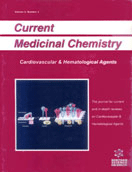Abstract
Protease activated receptor-1 (PAR-1), also known as thrombin receptor, is present in a variety of cell types such as platelets and endothelial cells. PAR-1 is proteolytically activated by thrombin by cleavage at its extracellular domain, unmasking a new amino terminus, which internally binds to the proximal receptor, eliciting cellular activation. Inhibition of the cellular activation by thrombin is a potentially promising therapeutic approach for the treatment of thrombotic and vascular proliferative disorders such as atherosclerosis and restenosis. Reported herein is the pharmacology of potent, low molecular weight thrombin receptor antagonists from pyrroloquinazoline, benzimidazole, and himbacine series. In the radioligand binding assay, these compounds inhibited PAR-1 in a competitive manner. They also inhibited thrombin and agonist peptide induced human platelet aggregation in a dose-dependent manner. Additionally, these compounds showed dose-dependent inhibition of agonist-induced cytosolic Ca+2 transients and thymidine incorporation in human coronary artery smooth muscle cells (hCASMC). The most potent compound among these antagonists showed a Ki of 12 nM in the radioligand binding assay and an IC50 of 70 nM in the platelet aggregation inhibition assay.
Keywords: antagonist, thrombin receptor antagonist, inhibitor, protease activated receptor, pyrroloquinazoline, benzimidazole, himbacine, trap
 16
16













